*Disclaimer
All rights belong to Wizards of the Coast
to see the full article, click here:

D&D-ESIGN, PART 1
Posted in Making Magic on July 5, 2021
Hello, and welcome to the first preview week of Dungeons & Dragons: Adventures in the Forgotten Realms. I'm going to start walking you through the set's design, introduce you to the Vision Design team, and show off some cool preview cards. You know, the usual.
YOU START AT A BAR MITZVAH
In 1980, I turned thirteen and had a bar mitzvah, a Jewish coming-of-age ceremony. I invited a lot of people to my bar mitzvah, including a neighbor who just happened to be my first-grade teacher. Her present for me was Dungeons & Dragons. I remember it came in a colorful box with a dragon on it, and the rulebook was an all-blue version of the same picture.
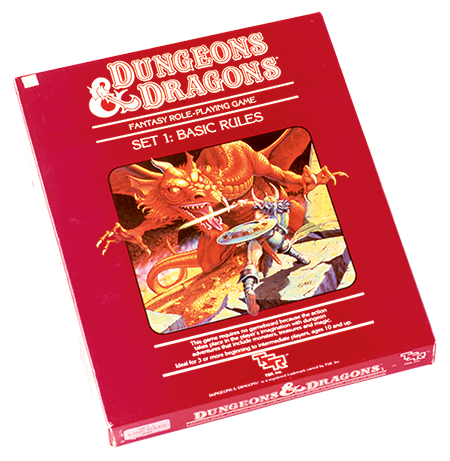
That began my interaction with the game Dungeons & Dragons. I played throughout junior high and high school, dabbled with the game a bit in college, and had a weekly campaign with my friends down in Los Angeles when I lived there. Here's a picture my roommate Chris drew of our party. (Chris wanted me to stress that he drew this many years ago in his youth.) I'm the wizard on the right with the glowing hands.
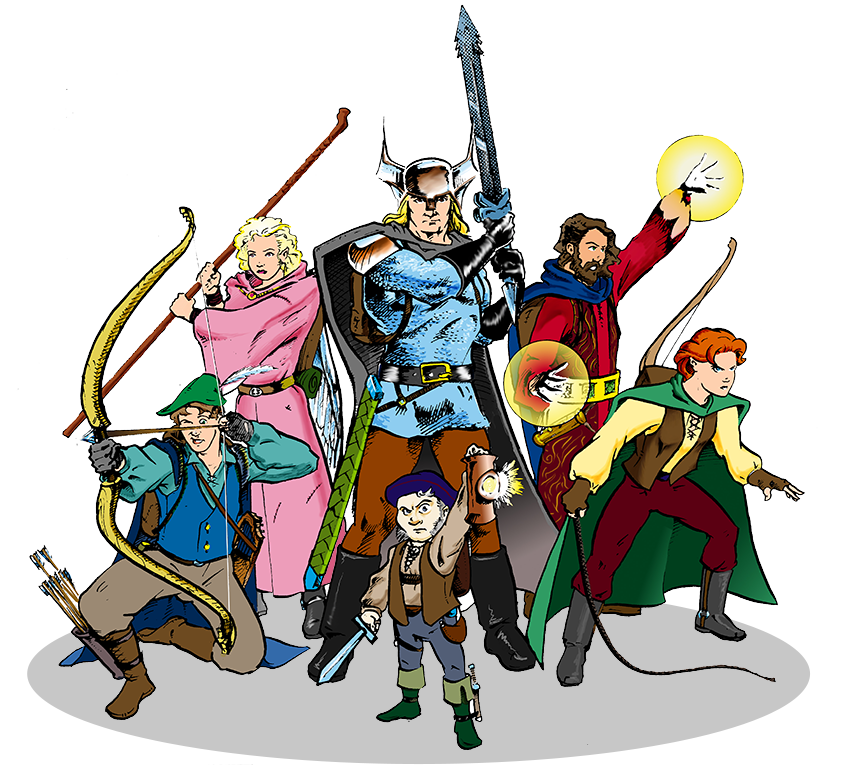
I wanted to start by bringing this up because I have a history with Dungeons & Dragons. I'm happy that Magic's first full set of another property is something to which I'm emotionally connected. If you're interested in hearing more about my experiences with Dungeons & Dragons, I wrote an article all about it back in 2007 (my third Topical Blend). I believe game designers are very influenced by the games they play (and enjoy), especially in their formative years, so I can see my D&D roots in my game design.
Interestingly, Dungeons & Dragons has had a lot of influence on Magic, beyond just me. Richard Garfield played D&D as a teen, and he credits it with helping him become a game designer. It was the first game he played where it made you a designer of the game. That stuck with him and heavily influenced how he designed Magic (and designed games in general). It was also one of the things that made him fall in love with the fantasy genre that, obviously, had a big impact on the game.
Wizards of the Coast was founded as a game company because its creators loved roleplaying, much of that shaped directly by Dungeons & Dragons. The legendary supertype was created in Legends because its designers wanted to bring characters from their roleplaying games into Magic.
In 1998, Wizards of the Coast bought Tactical Studies Rules, Inc. (TSR), and Dungeons & Dragons became a Wizards game. Many people who've worked on and influenced Magic first worked on D&D. Plus, as evidenced by Richard and me, a lot of people who've designed Magic were influenced by D&D. If we took an It's a Wonderful Life look at a world without Dungeons & Dragons, there's a high-percentage chance that Magic wouldn't exist, and even if it did, it would look very different.
YOU FORM A DESIGN TEAM
Before we get into how the set got made, I want to introduce the Vision Design team. Normally, I have the lead designer introduce their team, but as Andrew is no longer at Wizards, I'll be doing the introductions. Click below to meet the Dungeons & Dragons: Adventures in the Forgotten Realms Vision Design team.
-
CLICK HERE TO MEET VISION DESIGN
-
YOU GET MANY REQUESTS
Requests for a Dungeons & Dragons Magic set go all the way back to the early days of the game. It was a perfect flavor fit, and there was obviously a lot of overlap between Magic and D&D fans. Those requests got even louder when Wizards acquired D&D. The reasons we avoided it was a worry at Wizards that the two properties were already confused for one another by the public. Both are fantasy games, and most people didn't quite get the nuance of how they were different from one another, so we purposefully kept them apart.
This went on for numerous years. Magic was Magic, and D&D was D&D, and never the twain shall meet. That is, until James Wyatt (of the Vision Design team—see above) came from the D&D team to work on Magic.
James was on the Creative team and did a lot of the worldbuilding for various sets. One of his responsibilities was to write the copy for the art books that we began producing. (Something I believe James was instrumental in making happen.) James was creating a lot of text about the worlds, both for the needs of the set and for the art books. It dawned on James that these worlds would make good settings for a D&D campaign. Much of the work had already been done, so James decided to do the extra work necessary to put out books designed to let these worlds be played. The books were called Plane Shift, and James ended up making ones for Zendikar, Innistrad, Kaladesh, Amonkhet, Ixalan, and Dominaria. The popularity of the Plane Shift books inspired the D&D team to make source books for Ravnica and Theros.
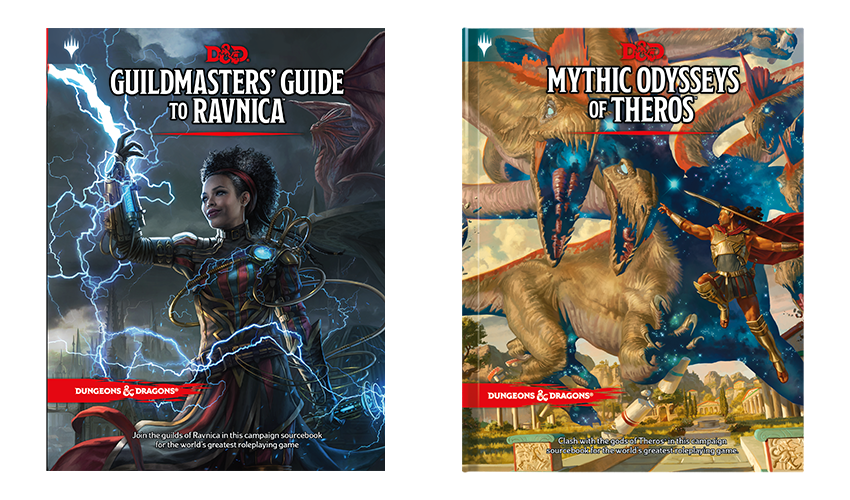
Seeing the D&D players get excited by Magic content inspired Vice President Bill Rose to re-examine the idea of using D&D content in Magic. (I also like to think this was partly inspired by the D&D-ish design work we were doing in Zendikar Rising.)
Bill's idea was simple. Every summer, we make a core set. Each core set has a small theme. One year was focused on Nicol Bolas, another on Chandra, and another on Teferi. What if one core set's theme wasn't a different Magic character, but D&D? It would give the core set its own identity and maybe even draw some new players to the game.
Bill decreed that the core set for the summer of 2021 would have a D&D theme. The D&D team had given the project the okay, with the one stipulation that they wanted it set in the Forgotten Realms.
I like showing you guys actual documents, and Andrew created a great write-up as part of his handoff that gives a good sense of the feel they were shooting for. I think it will help you all understand the larger tone that Andrew and his team wanted to capture (again, this next part was written by Andrew; it's slightly edited due to some stuff that's not public):
-
CLICK HERE TO READ ANDREW'S WRITE-UP
-
Hi. It's me (Mark) talking again. As you can see from the write-up, the set had a lot to live up to. D&D is a beloved game that many people have played for a long time. The anticipation for a Magic D&D set had been building for decades. There was a lot of pressure to make a set that both felt like Magic but also felt like D&D. Andrew and his Vision Design team had their work cut out for them.
YOU REALIZE THINGS ARE CHANGING
The design began with Andrew and the team making a D&D-flavored core set. First, they looked to see if there were simple spells that already existed that felt like D&D, things like Throne of Eldraine's Charmed Sleep. Second, they began taking spells you would expect to see in a core set and giving them a D&D flavor, things like a direct-damage spell being called Magic Missile. Third, they took D&D concepts and designed simple top-down cards. As they were designing these cards, they found themselves making cards more complex than we'd put in a core set. Not every idea could be translated to something simple, and these were cool designs, so they put them in the set.
Then they started talking about whether they wanted a mechanic (you might have noticed Andrew talking about new mechanics up above). Core sets no longer use non-evergreen mechanics, but they used to. Maybe the D&D set could make an exception. Maybe they could use just one mechanic. Maybe it didn't need to be a returning mechanic. Maybe it could be a new mechanic. Maybe the set could have more than one non-evergreen mechanic. The maybes started adding up, and little by little, the set started getting more complex. This, of course, led to an important question, "Is this set supposed to be getting more complex?"
This brought up discussion of Magic: Origins. It was a core set, kind of. It had two new mechanics and brought back an old one (transform/double-faced cards). It was more complex than a normal core set, but we did call it a core set. Maybe the D&D set was like Magic: Origins. It could be a core set-plus. The individual top-down card designs had been exciting everyone in The Pit, so okay, core set-plus it was.
Meanwhile, Zendikar Rising is in late set design, and it's going well. The set, by nature of its adventure world flavor, had pushed in a very D&D-like direction, and people were responding quite positively to it. Also, R&D had been spending a lot of time talking about Universes Beyond, an idea that Aaron had pitched about designing Magic cards that used other properties. This had raised a lot of discussion about what properties were best, and while there was much disagreement on how to order the list, everyone seemed to agree on one thing—D&D was a perfect fit. As this was our first whole set using another property, maybe we wanted to lean more into it than we had been? Maybe a core set-plus wasn't enough?
There was a lot of debate about what exactly the D&D set was supposed to be. Finally, it was decided "to just make it the best D&D set it could be." It no longer had to be thought of as a core set. That didn't mean it might not end up a core set, but the designers no longer had to think of it as one. Just make the best Magic D&D set they could. This would lead to new mechanics, components outside the game, dice rolling, a new approach to flavoring mechanics, and much more. All of which I'll talk about next week in part two.
YOU FIND COOL NEW STUFF
Before I let you go for today, though, I have three preview cards to show off, all of which are white. I'll start with a white Dragon. For those unaware, the five main colors of dragons in D&D are white, blue, black, red, and green. That was too much of a fortuitous coincidence to pass up, so the set has an uncommon cycle of Dragons.
-
CLICK HERE TO MEET WHITE DRAGON
-
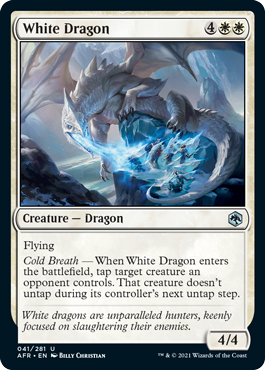
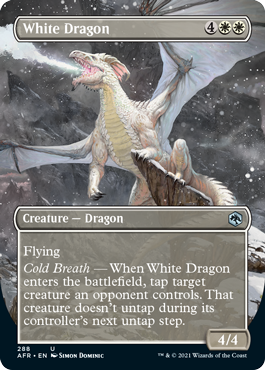
Next up is a Monk, one who likes you casting a lot of spells.
-
CLICK HERE TO MEET MONK OF THE OPEN HAND
-
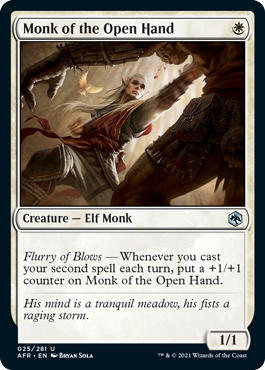
Finally, I get to show off the white planeswalker for the set. This is a character with another name you might know them by: Bahamut.
-
CLICK HERE TO MEET GRAND MASTER OF FLOWERS
-
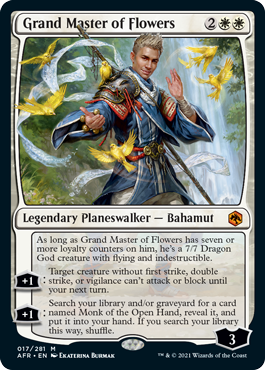
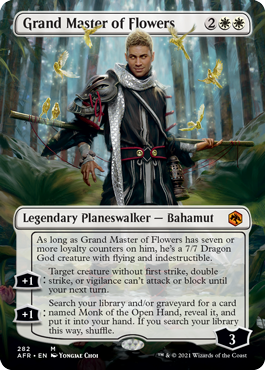
YOU REST FOR THE NIGHT
That's all the time we have for today. I hope you enjoyed the beginning of our design tale. As always, if you have any feedback, either on the article or on Adventures in the Forgotten Realms itself, you can email me or contact me through any of my social media accounts (Twitter, Tumblr, Instagram, and TikTok).
Join me next week when I started talking about the mechanics and themes of the set.
Until then, may you embrace a property you already love or learn more about a new one.
#847: UNSTABLE WITH BEN HAYES
#847: UNSTABLE WITH BEN HAYES
I sit down with R&D member Ben Hayes to talk about the making of Unstable.
#848: MINI-MASTER
#848: MINI-MASTER
31:31
This podcast talks about one of my favorite formats, including its origin, which digs into the early days of the Los Angeles Magic scene.
- Episode 846 Planeswalkers, Part 3
- Episode 845 Modern Horizons with Mark Globus
- Episode 844 Tempest Story, Part 2



